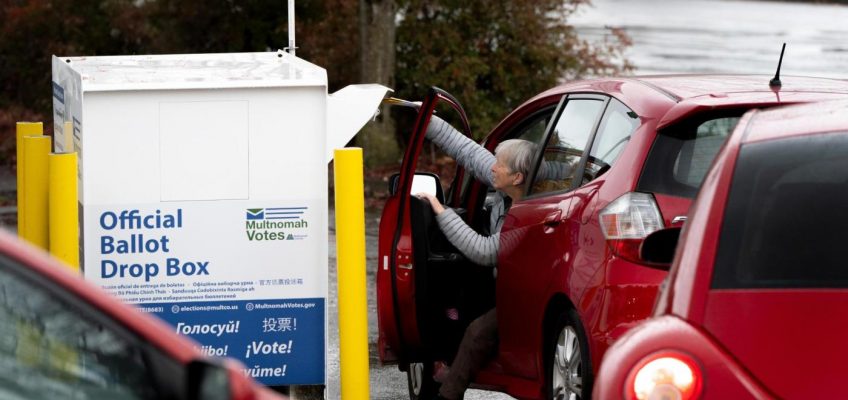By NICHOLAS RICCARDI and ALI SWENSON
President Donald Trump on Monday vowed more changes to the way elections are conducted in the U.S., but based on the Constitution there is little to nothing he can do on his own.
Judge issues injunction preventing Trump’s FTC from investigating watchdog Media Matters
Justice Department to begin giving Congress files from Jeffrey Epstein investigation, lawmaker says
20 states and DC sue DOJ to stop immigration requirements on victim funds
Mississippi becomes fourth state to send National Guard troops to DC in expanding federal crackdown
What to know about redistricting fights as Texas Democrats return and California starts work
Relying on false information and conspiracy theories that he’s regularly used to explain away his 2020 election loss, Trump pledged on his social media site that he would do away with both mail voting — which remains popular and is used by about one-third of all voters — and voting machines — some form of which are used in almost all of the country’s thousands of election jurisdictions. These are the same systems that enabled Trump to win the 2024 election and Republicans to gain control of Congress.
Trump’s post marks an escalation even in his normally overheated election rhetoric. He issued a wide-ranging executive order earlier this year that, among other changes, would have required documented proof-of-citizenship before registering to vote. His Monday post promised another election executive order to “help bring HONESTY to the 2026 Midterm elections.”
The same post also pushed falsehoods about voting. He claimed the U.S. is the only country to use mail voting, when it’s actually used by dozens, including Germany, Switzerland and the United Kingdom.
Similar complaints to Trump’s, when aired on conservative networks such as Newsmax and Fox News, have led to multimillion dollar defamation settlements, including one announced Monday, because they are full of false information and the outlets have not been able to present any evidence to support them.
Trump’s post came after the president told Fox News that Russian President Vladimir Putin, in their Friday meeting in Alaska, echoed his grievances about mail voting and the 2020 election. Trump continued his attack on mail voting and voting machines in the Oval Office on Monday, during a meeting with Ukrainian President Volodymyr Zelenskyy.
President Donald Trump greets Russia’s President Vladimir Putin Friday, Aug. 15, 2025, at Joint Base Elmendorf-Richardson, Alaska. (AP Photo/Julia Demaree Nikhinson)
The announcement signals yet another way that Trump intends to stack the cards in his favor in the 2026 midterm elections, after he already has directed his attorney general to investigate a Democratic fundraising platform and urged states to redraw their congressional districts to help the GOP maintain its majority in the House of Representatives.
Here’s a breakdown of Trump’s latest election post and why Congress is the one entity that can implement national election rules.
Trump’s post
Trump for years has promoted false information about voting, and Monday was no exception.
He claimed there is “MASSIVE FRAUD” due to mail voting, when in fact voting fraud in the U.S. is rare. As an example, an Associated Press review after the 2020 election found fewer than 475 cases of potential fraud in the six battleground states where he disputed his loss, far too few to tip that election to Trump.
Washington and Oregon, which conduct elections entirely by mail, have sued to challenge Trump’s earlier executive order — which sought to require that all ballots must be received by Election Day and not just postmarked by then. The states argue that the president has no such authority, and they are seeking a declaration from a federal judge in Seattle that their postmark deadlines do not conflict with federal law setting the date of U.S. elections.
Trump also alleged that voting machines are more expensive than “Watermark Paper.” That’s a little-used system that has gained favor and investments among some voting conspiracy theorists who believe it would help prevent fraudulent ballots from being introduced into the vote count. Watermarks would not provide a way to count ballots, so they would not on their own replace vote tabulating machines.
FILE – A person votes at a polling site for the presidential primary election March 12, 2024, in Atlanta. (AP Photo/Brynn Anderson, File)
While some jurisdictions still have voters use electronic ballot-marking devices to cast their votes, the vast majority of voters in the U.S. already vote on paper ballots, creating an auditable record of votes that provides an extra safeguard for election security.
In his post, Trump also claimed that states “are merely an ‘agent’ for the Federal Government in counting and tabulating the votes” and must do what the federal government “as represented by the President of the United States” tells them to do.
Election lawyers said that’s a misrepresentation of the U.S. Constitution. It also flies in the face of what had been a core Republican Party value of prioritizing states’ rights.
Thousands of elections, none under presidential control
Unlike in most countries, elections in the U.S. are run by the states. But it gets more complicated — each state then allows smaller jurisdictions, such as counties, cities or townships, to run their own elections. Election officials estimate there are as many as 10,000 different election jurisdictions across the country.
A frequent complaint of Trump and other election conspiracy theorists is that the U.S. doesn’t run its election like France, which hand counts presidential ballots and usually has a national result on election night. But that’s because France is only running that single election, and every jurisdiction has the same ballot with no other races.
A ballot in the U.S. might contain dozens of races, from president on down to city council and including state and local ballot measures.
The Constitution makes the states the entities that determine the “time, place and manner” of elections, but does allow Congress to “make” or “alter” rules for federal elections.
Congress can change the way states run congressional and presidential elections but has no say in the way a state runs its own elections. The president is not mentioned at all in the Constitution’s list of entities with powers over elections.
“The president has very limited to zero authority over things related to the conduct of elections,” said Rick Hasen, an election law professor at the University of California, Los Angeles.
Courts have agreed — no presidential involvement
Parts of Trump’s earlier executive order on elections were swiftly blocked by the courts, on the grounds that Congress, and not the president, sets federal election rules.
It’s unclear what Trump plans to do now, but the only path to change federal election rules is through Congress.
Although Republicans control Congress, it’s unclear that even his party would want to eliminate voting machines nationwide, possibly delaying vote tallies in their own races by weeks or months. Even if they did, legislation would likely be unable to pass because Democrats could filibuster it in the U.S. Senate.
Mail voting had bipartisan support before Trump turned against it during the COVID-19 pandemic and the 2020 election, but it’s still widely used in Republican-leaning states, including several he won last November — Arizona, Florida and Utah. It’s also how members of the military stationed overseas cast their ballots, and fully eliminating it would disenfranchise those GOP-leaning voters.
The main significance of Trump’s Monday statement is that it signals his continuing obsession with trying to change how elections are run.
“These kinds of claims could provide a kind of excuse for him to try to meddle,” Hasen said. “Very concerned about that.”
Associated Press writer Eugene Johnson in Seattle contributed to this report.




